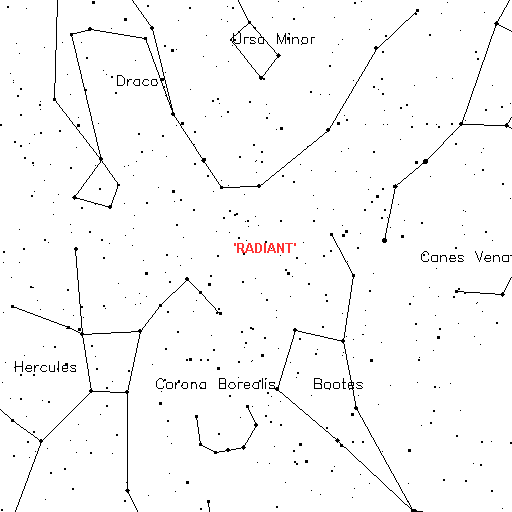Quadrantid Meteor Shower Will Sparkle on January 3rd

Beginning each New Year and lasting for nearly a week, the Quadrantid Meteor Shower sparkles across the night sky for nearly all viewers around the world. Its radiant belongs to an extinct constellation once known as Quadran Muralis, but any meteors will seem to come from the general direction of bright Arcturus and Boötes. This is a very narrow stream, which may have once belonged to a portion of the Aquarids, but recent scientific data points to a what may have been a cosmic collision.
According to NASA, scientists believe this could be the most brilliant meteor shower in 2008 with over 100 visible meteors per hour at its peak. Best viewing times with the highest meteor rates are expected to be in either the late evening of Jan. 3 over Europe and western Asia or the early morning of Jan. 4 over the eastern United States. For the USA: 6pm – 2am (Pacific Time) on Jan. 3 and 4, 2008. For Northern Europe: 2am – 10am (London) on Jan. 4, 2008. For Northern Asia: 11am – 7pm (Tokyo) on Jan. 4, 2008. For almost of us, this means bundling up against the cold and battling the remnants of the waning Moon… But the sight of even one "shooting star" can make the trip worthwhile!

Beginning each New Year and lasting for nearly a week, the Quadrantid Meteor Shower sparkles across the night sky for nearly all viewers around the world. Its radiant belongs to an extinct constellation once known as Quadran Muralis, but any meteors will seem to come from the general direction of bright Arcturus and Boötes. This is a very narrow stream, which may have once belonged to a portion of the Aquarids, but recent scientific data points to a what may have been a cosmic collision.
According to NASA, scientists believe this could be the most brilliant meteor shower in 2008 with over 100 visible meteors per hour at its peak. Best viewing times with the highest meteor rates are expected to be in either the late evening of Jan. 3 over Europe and western Asia or the early morning of Jan. 4 over the eastern United States. For the USA: 6pm – 2am (Pacific Time) on Jan. 3 and 4, 2008. For Northern Europe: 2am – 10am (London) on Jan. 4, 2008. For Northern Asia: 11am – 7pm (Tokyo) on Jan. 4, 2008. For almost of us, this means bundling up against the cold and battling the remnants of the waning Moon… But the sight of even one "shooting star" can make the trip worthwhile!

